How To Make Your Page Titles SEO-Friendly

The HTML title has long been considered the most important element of a web page.
Especially where on-page SEO is concerned.
But what is it? And how do you create a title tag that will help your page rank higher in Google and get more clicks from search results?
Let’s see:
What is the page title tag?
A title tag is an HTML code that contains a page title.
The title is not visible on the page itself. You can only see it on the browser tab.
The purpose of this HTML tag is to describe the page.

Why is the page title so important?
For usability, titles play a very distinct role: They help users distinguish a tab with the page they need in their browsers.
Titles are also used in browser bookmarks, unless a user chooses to rename the saved page.
Page titles are also used to generate social media snippets giving users basic page info before they decide if they want to click:
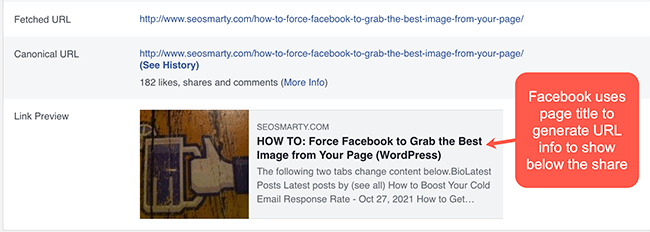
When it comes to SEO, page titles have been widely discussed because Google used them to generate the search snippets.

Historically Google has claimed page titles to be the most important SEO elements because they allow the search algorithm to identify what the page is about.
And because Google used titles to generate search snippets, search titles could help organic click-through.
Basically: Your choice of a page title could impact both its organic rankings and click-through.
It’s no longer exactly the case.
Google and titles: What has changed?
Over the years, Google has become smarter and less predictable and that has a huge impact on how they perceive titles. From now on:
- Optimizing titles doesn’t necessarily translate in higher rankings
- Google no longer bolds keyword in the title, so there’s no such a huge impact on click-though
- Google doesn’t always use titles to generate search snippets
Let’s look at both of these in a bit more detail.
Optimizing titles doesn’t necessarily translate in higher rankings
When Google started, it was pretty straightforward: Use your keywords in the document, Google will match them with each search query and if yours match, your document will show up for that search (exactly where it will show up will also rely on your backlinks).
Over the years, Google’s algorithm has matured beyond keyword matching.
It can now determine search intent and return results that meet that intent whether they mention that keyword (i.e. search query) or use alternative wording.
In the old SEO days, to rank your page for something like [how to design a pin] you needed a page with exactly that title, plus some backlinks pointing to it.
These days, Google understands that [how to design a pin] may very well be about making pins, so you don’t have to optimize your title or page for each query anymore:
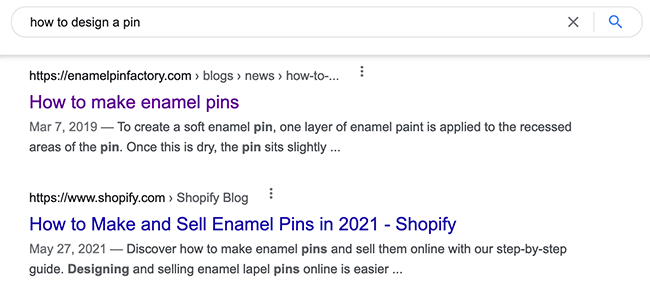
Google no longer bolds keyword in the title, so there’s no such a huge impact on click-though
Back in the old SEO days, Google would use bold for every keyword matched in the title tag making those search snippets really stand out.
The more keywords you were able to stuff in your title tag, the more clicks it would get.
These days, all titles look plain, whether they have keywords in them or not. It has become harder to impact click-through using title tags these days:
Before:
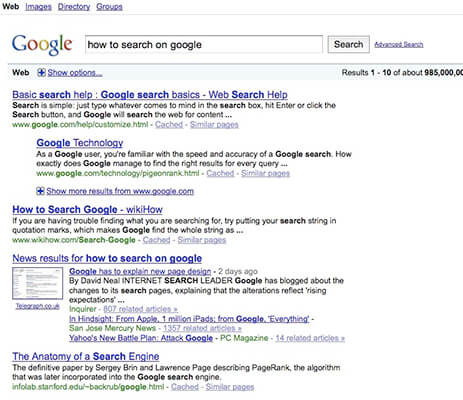
After:

Note: You can still improve organic click-through by using rich and structured snippets.
Google doesn’t always use titles to generate search snippets
Finally, slowly but surely Google has been finding alternative data sources to create the search snippets. Ever since 2012, website owners have been noticing that Google is changing their title tags and showing something else in search.
These days, this happens more and more often: Bloggers just don’t have that much control over what Google shows in search, and that has led to an important question:
Are titles still important?
They are!
- Title is still the best way to render the meaning and value of the page
- Titles are still important for usability
- Titles are still used in social media sharing
- Titles are still the most important on-page SEO element, especially if you optimize if well…
So how can we still make the most of title tag optimization?
How to optimize title for Google
Let’s start with Google’s own explanation why they have been relying less and less on title tags:
- Some titles were very long
- Google doesn’t like over-optimized titles with many keyword variations in them
With that in mind, here are important steps to optimizing your HTML title tags:
1. Keep your titles short
As you may have noticed above, Google cites the title tag length as the first reason for changing it when creating the search snippet.
Logically, the title tag length is one of the major factors for Google.
Unfortunately, there’s no clear guidelines as to how long is too long.
All we know is that Google would display no more than 70 characters of your title and truncate the rest.
This is a good starting point but don’t go crazy here. If you regularly look through Google’s search engine result pages, you know that lots of titles are truncated, so many of them go beyond the 70-character limit.
I tend to stick to a more flexible rule:
- Keep your title tag around 100 characters
- Make sure that the most important part of the title comes first, so Google can easily truncate it without losing the meaning.
2. Avoid stuffing your keywords in titles
Just a few years ago one of SEO best practices used to be “include as many keyword variations in your title as you can”. We would happily put in plural and singular forms, reverse ordered phrases and even include misspellings.
And it worked.
These days Google understands much more about people’s searching behaviors and it would consider keyword-stuffed titles spammy.
Instead of stuffing the same (or slightly varying) keyword phrases into your title, consider making it more descriptive to better match keyword intent:
- Bad: Learn Marketing: Cheap Online Courses and Free Marketing Classes
- Better: Learn Marketing with Free Online Courses and Certifications
- Even better: XX Online Courses to Learn (Digital) Marketing for Free
3. Mind your searcher’s intent
What is it your target reader likely to intend to do when searching for a relevant keyword? What are their expectations from the content they are going to find? Are they looking for a list of options or a detailed explanation of a single concept? Are they doing research in preparation for some further action (e.g. buy something or go somewhere)?
Whatever it is, it is a good idea to reflect that search intent in the title:
- If you think your target searcher is looking for a list of options, give an exact number: How many of those options are going to be presented in your article.
- If your target reader is likely to research a single option, point out which questions are going to be addressed in your content.
To better understand your target readers’ expectations, run a quick search in Text Optimizer which will cluster your target keyword into related concepts and entities (i.e. brand names your readers expect to be covered in your content).
This is a great way to pick up some key things to include in the title alongside your main keyword:
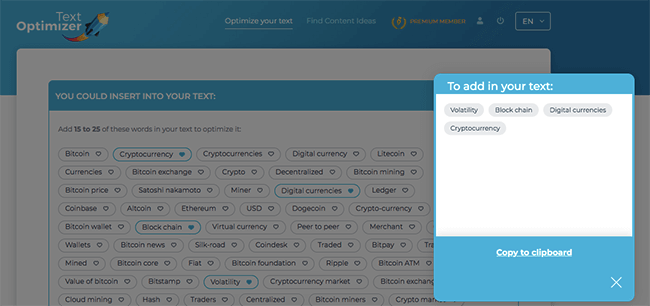
4. Make sure your H1 tag is prominent on the page
One of the prominent points in Google’s announcement is that they want users to be comfortable when landing on the page by clicking a link in search results. More specifically, Google thinks that their user needs to see the same headline they clicked from their SERPs.
Therefore Google would often use the H1 tag from the page instead of its title.
Logically, to get a better control over your search snippet, follow these two steps:
- Make sure your title and H1 are the same. This will happen in WordPress by default. This advice actually contradicts with a “best SEO practice” you’ll come across when researching on-page SEO. Most of those SEO guidelines were written prior to Google’s announcement though.
- Make your H1 headline prominent on the page, so that people clicking the same headline in Google SERPs will immediately see it on the page (and feel more like staying and engaging with your page)
Years of optimizing for Google have taught me one thing: They never assume things. If they think something helps usability, it always comes as a result of testing and surveying. So using this tip you may also improve your on-page engagement, which is great!
5. Brand your titles where it makes sense
Google mentions that including your brand name is important but it also mentions that it is only important where it is useful and helpful, like on the home page.
If you have found a great business name and you are interested in promoting it, make sure you include it on your brand-driven pages, like “About us”, blog home page, contact page, etc.
But think twice before including your name on all pages of your site. It will make your titles longer and may force Google to truncate them in search results or even modify it.
That being said, if you notice Google changing a lot of your titles, consider removing the brand name from them. That’s the fastest way to make your title tags shorter.
6. Keep your titles useful
Any time you are crafting your page title, ask yourself one question: Would it help my target reader understand what my page is about?
Instead of trying to come up with a search-optimized title that will get clicks, try to come up with an informative and useful title. Google always prioritizes its users, so the best SEO practice is to put your reader first and create a customer-centric content strategy.
Include your whole team into the process: Collect their feedback on what they think will be the most useful title tag for each page. Cross-team collaboration is an important SEO practice these days which relies on the company’s unified communications.
Whether you have an in-house team or a few freelancers helping you operate your blog, include them in your SEO strategy as much as possible.
Monitor your search snippets
Google’s results are versatile, they are hard to keep up with. You may already be monitoring your rankings. But are you keeping an eye on your search snippets, at least those coming up for your most important search queries?
Visualping is a great tool allowing you to set up all kinds of monitoring, including SERP monitoring. Visualping allows to set up monitoring for a certain part of the page, so you can monitor only your own snippet and get notified when Google modifies your title:
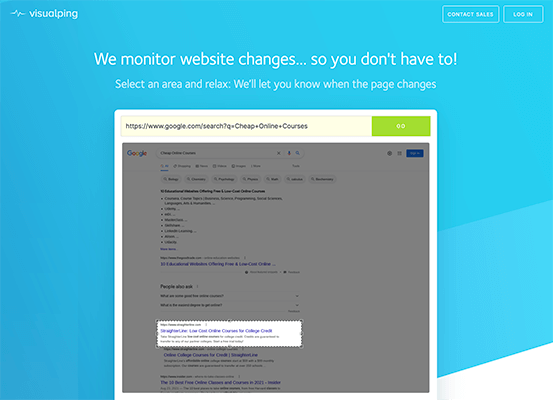
This is a great tool for automated SEO maintenance.
Additionally, keep an eye on your Search Console dashboard to spot some articles that have lost some organic click-through and check whether Google has modified those search snippets as well.
Conclusion
Change is inevitable, especially when it comes to such a fast-evolving industry like SEO. Yet, one thing remains constant: If you want Google to “like” your site, make it useful for your users.
Blog as if Google never existed is a good practice. It means that you need to prioritize your target reader. Yet, making it easier to find and understand for a search crawler won’t hurt.
HTML title tags remain the most important on-page element helping search engines understand the core meaning of the page. Keep your titles useful, descriptive and concise for Google to use them to form your search snippets.
Further Reading:
